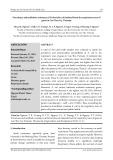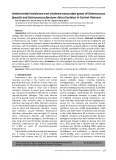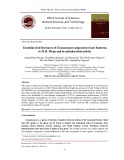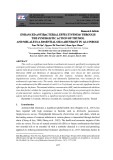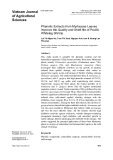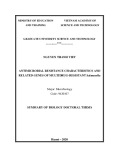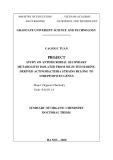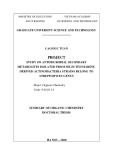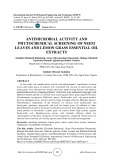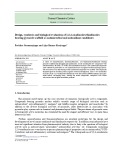Zinc potentiates the antibacterial effects of histidine-rich peptides against Enterococcus faecalis Victoria Rydenga˚ rd, Emma Andersson Nordahl and Artur Schmidtchen
Section of Dermatology and Venereology, Department of Clinical Sciences, Lund University, Sweden
Keywords antimicrobial peptide; Enterococcus faecalis; heparin; high molecular weight kininogen; zinc
Correspondence V. Rydenga˚ rd, Department of Clinical Sciences, Lund University, Biomedical Center B14, Tornava¨ gen 10, SE221 84 Lund, Sweden Fax: +46 46 157 756 Tel: +46 46 222 3315 E-mail: victoria.rydengard@med.lu.se
(Received 14 February 2006, revised 21 March 2006, accepted 23 March 2006)
Antimicrobial peptides are effector molecules of the innate immune system. We have recently shown that peptides containing multiples of the heparin- binding Cardin and Weintraub motifs AKKARA and ARKKAAKA exert antimicrobial activities. Here, we show that replacement of lysine and arginine in these motifs by histidine abrogates the antibacterial effects of these peptides. Antibacterial activity of the histidine-rich peptides against the Gram-positive bacterium Enterococcus faecalis was restored by the addition of Zn2+. Fluorescence microscopy experiments showed that Zn2+ enabled binding of the histidine-rich peptides to Enterococcus faecalis bac- teria. Similar Zn2+-dependent antibacterial activities were shown for hista- tin 5 as well as histidine-containing peptides derived from the Zn2+- and heparin-binding domain 5 of human kininogen. Thus, the results demon- strate a previously undisclosed Zn2+-dependent antibacterial activity of kininogen-derived peptides and indicate an important role for Zn2+ in regulating the antimicrobial activities of histidine-rich peptides.
doi:10.1111/j.1742-4658.2006.05246.x
Antimicrobial substances in blood and leukocytes were discovered over 100 years ago [1]. The identification of antimicrobial peptides (AMPs) in polymorphonuclear leukocytes [2] was followed by their molecular charac- terization [3,4]. The subsequent discovery of AMPs in invertebrates [5] and cold-blooded vertebrates [6] emphasized the evolutionary importance of this group of host-defence molecules. At present, over 800 differ- ent AMP peptide sequences are known (http://www. bbcm.univ.trieste.it/(cid:1)tossi/search.htm). Many AMPs adopt an amphipathic structure, in which clusters of hydrophobic and cationic amino acids are spatially organized in sectors of the molecules. Thus, peptides may be grouped into linear peptides, which adopt an a-helical and amphipathic conformation upon enter- ing a bacterial membrane, peptides composed of cysteine-linked antiparallel b sheets, peptides with a cysteine-constrained loop structure, or peptides with an over-representation of some amino acids [7,8]. It is
well established that bacterial binding, and thus inter- action with bacterial membranes, is a prerequisite for the modes of action of AMP function. However, AMPs on their target bacteria are complex, and can be divided into membrane and nonmembrane disrup- tive. Amphipathic and a-helical AMPs, such as the human cathelicidin LL-37, are able to interact with bacterial surface components such as lipopolysaccha- ride and peptidoglycans, leading to the induction of an a-helical conformation, which in turn facilitates membrane interactions, membrane destabilization and finally, bacterial killing [9]. In contrast, other AMPs, such as the porcine cathelicidin PR-39 and human his- tatins, function by less well-elucidated mechanisms. Whereas PR-39 blocks bacterial DNA and protein synthesis [10], histatins translocate through membranes [11] and bind to a receptor in the fungal mitochon- drion, where they may induce cell death by nonlytic ATP release, the generation of reactive oxygen species
Abbreviations AMP, antimicrobial peptide; HMWK, high molecular weight kininogen.
FEBS Journal 273 (2006) 2399–2406 ª 2006 The Authors Journal compilation ª 2006 FEBS
2399
V. Rydenga˚ rd et al.
Antibacterial histidine-rich peptides
(Cardin
sequences
and induction of G1 phase arrest [12,13]. Apart from their antimicrobial activities, AMPs also interact with negatively charged glycosaminoglycans, including hep- arin [14]. Conversely, we recently showed that several naturally occurring cationic peptide segments with heparin-binding capabilities, including the anaphyla- toxin C3a and histidine- and lysine-rich peptides of domain 5 of human high molecular weight kininogen (HMWK), were antimicrobial [15,16]. In conjunction with these findings, consensus heparin-binding pep- tide and Weintraub motifs) XBBBXXBX or XBBXBX (where X represents hydro- phobic or uncharged amino acids, and B represents basic amino acids), represented by multiples of the motifs ARKKAAKA or AKKARA [17], have been shown to be antibacterial against the Gram-positive bacterium Enterococcus faecalis and the Gram-negative Pseudomonas aeruginosa and Escherichia coli [18]. The starting point for this study was the observation that histidine-rich peptides, such as those derived from the histidine- and glycine-rich domain 5 of HMWK require Zn2+ for interaction with heparin. Here we show that these kininogen-derived peptides, and the prototypic histidine-rich Cardin and Weintraub pep- tides, are antimicrobial in the presence of Zn2+, thus disclosing an interesting role for this divalent cation in the regulation of antimicrobial activities of histidine- rich peptides.
Results
Antimicrobial activities of histidine-rich peptides containing heparin-binding motifs
As previously shown, Cardin and Weintraub motif peptides (AKKARA)4 (AKK24) and (ARKKAAKA)3 (ARK24) (Table 1) interact with heparin [17] and exert antimicrobial effects mediated by the disruption of to study the bacterial membranes
In order
[18].
Table 1. Peptides analysed in this study.
Protein
Peptide
Sequence
Cardin motifs
HMW kininogen
AKKARAAKKARAAKKARAAKKARA AKK24 ARK24 ARKKAAKAARKKAAKAARKKAAKA AHH24:1 AHHAHAAHHAHAAHHAHAAHHAHA AHH24:2 AHHHAAHAAHHHAAHAAHHHAAHA KHN20 GHG20 GHG21 GGH20 HKH20
Histatin-5
KHNLGHGHKHERDQGHGHQR GHGLGHGHEQQHGLGHGHKF GHGHKFKLDDDLEHQGGHVLD GGHVLDHGHKHKHGHGHGKH HKHGHGHGKHKNKGKKNGKH DSHAKRHHGYKRKFHEKHHSHRGY
the antimicrobial and heparin-binding activities of corresponding histidine-substituted peptide motifs, peptides in which amino acids R and K were replaced by H were synthesized, thus yielding the sequences (AHHAHA)4 and (AHHHAAHA)3, denoted AHH24:1 and AHH24:2, respectively (Table 1). An established slot-binding assay was used to screen for heparin bind- ing [17]. The results showed that the 24-amino acid histidine-rich amphipathic peptides displayed weak binding to radiolabelled heparin in 10 mm Tris, pH 7.4. Addition of 50 lm Zn2+ to the buffer increased heparin binding (Fig. 1A, upper). In contrast, the AKK24 and ARK24 peptides bound heparin in the absence and presence of Zn2+ (Fig. 1A, lower). Next, we investigated the effects of these peptides on bac- teria; specifically, we wanted to study the potential enhancement of peptide antibacterial activities by Zn2+. As previous reports have shown that Zn2+ may exert antibacterial effects per se [19], we first screened var- ious Gram-positive and Gram-negative bacteria for susceptibility to Zn2+. As shown in Table 2, among the bacteria tested, the Gram-positive E. faecalis dem- onstrated least sensitivity to Zn2+, and was therefore selected for further analyses. Thus, E. faecalis 2374 bacteria were incubated with the lysine and arginine- containing peptides AKK24 and ARK24, or the two histidine-containing peptides AHH24:1 and AHH24:2. Whereas AKK24 and ARK24 effectively killed bac- teria at (cid:1) 1 lm, little or no antibacterial effects of the AHH peptides were detected in Tris buffer at pH 7.4 (Fig. 1B). However, both AHH peptides exerted anti- bacterial effects in the presence of 50 lm Zn2+. At this Zn2+ concentration, an antibacterial effect was noted at peptide concentrations of 0.1–1 lm. However, we repeatedly noted diminished antibacterial activity at peptide concentrations of 3–6 lm (molar Zn2+ to pep- tide ratio of (cid:1) 10). Hypothetically, this may be due to Zn2+–peptide complex formation, or peptide oligomer- izations at certain threshold levels of Zn2+ to AHH peptide, leading to inhibition of peptide interactions with bacterial membranes. The findings that the inhibi- tion was abolished at higher peptide concentrations (Fig. 1B), as well as using a constant molar excess of Zn2+ to peptide (Fig. 1C), is compatible with this hypothesis. In contrast to experiments with the AHH peptides, the AKK24 and ARK24 peptides displayed no enhancement of antibacterial activity in the pres- ence of Zn2+ (Fig. 1B). Next, we investigated the effect of peptides AHH24:1 and AHH24:2 against dif- ferent strains of E. faecalis in buffer with or without 50 lm Zn2+. The results showed that the strains were sensitive to 100 lm AHH peptides in the presence of 50 lm Zn2+ (Fig. 1D).
FEBS Journal 273 (2006) 2399–2406 ª 2006 The Authors Journal compilation ª 2006 FEBS
2400
V. Rydenga˚ rd et al.
Antibacterial histidine-rich peptides
Fig. 1. Heparin-binding and antibacterial effects of peptides containing Cardin and Weintraub motifs. (A) Slot-binding assay. Peptides (AHH24:1, AHH24:2, AKK24 and ARK24, at 2 and 5 lg) were applied to nitrocellulose membranes followed by incubation with iodinated (125I) heparin in 10 mM Tris, pH 7.4 in the absence (–) or presence (+) of 50 lM Zn2+. Radioactivity was visualized using a phosphorimager system. (B) Antibac- terial assays. E. faecalis 2374 (2 · 106 cfuÆmL)1) were incubated for 2 h at 37 (cid:1)C with the indicated peptides at concentrations of 0.03–60 lM in 10 mM Tris, pH 7.4 alone (d), or in the presence of 50 lM Zn2+ (s), and the number of cfu was determined. (C) Antibacterial activities of the AHH24 peptides in the presence of a fixed molar excess of Zn2+. E. faecalis 2374 bacteria were incubated with AHH24:1 (d) and AHH24:2 (s) at the indicated concentrations in buffer containing a 100· molar excess of Zn2+ (relative to the peptide concentration). (D) Antibacterial effects of AHH24:1 and AHH24:2 against different strains of E. faecalis. In viable-count assays, the indicated E. faecalis bacterial isolates were incuba- ted with 100 lM of the AHH24 peptides in 10 mM Tris buffer, pH 7.4 (black bars) or in the same buffer containing 50 lM Zn2+ (white bars). Error bars indicate standard deviation (***P < 0.001, n ¼ 6).
Analysis of peptide binding to bacterial membranes and the effects of ions
Having shown a prerequisite for Zn2+ in bacterial killing, we analysed the influence of Mg2+ and Ca2+ on the antibacterial activities of AHH peptides. As shown in Fig. 2B, only Zn2+ significantly increased bacterial killing.
Antimicrobial activities of peptides derived from HMWK
Domain 5 of HMWK contains two subdomains. One domain is His–Gly rich (K420–D474) and one His– Gly–Lys rich (G474–K502). As shown by Pixley et al. [20], the heparin-binding activity of the His–Gly-rich domain is Zn2+ dependent, whereas the His–Gly–Lys-
To examine whether the AHH peptides interact with bacterial membranes, AHH24:1 and AHH24:2 were labelled using the fluorescent dye Texas Red and incu- bated with E. faecalis 2374 bacteria in the absence or presence of 50 lm Zn2+. As shown by fluorescence microscopy analysis, the peptides bound to the bac- teria in the presence of Zn2+ (Fig. 2A). Furthermore, binding was completely blocked by heparin, thus indi- rectly demonstrating the heparin-binding capability of these peptides. Heparin did not quench the fluores- cence of Texas Red-labelled peptides (not shown).
FEBS Journal 273 (2006) 2399–2406 ª 2006 The Authors Journal compilation ª 2006 FEBS
2401
V. Rydenga˚ rd et al.
Antibacterial histidine-rich peptides
Table 2. Effects of Zn2+ on various Gram-positive and Gram-negative bacteria. The indicated bacteria were incubated for 2 h in 10 mM Tris, pH 7.4, alone or in the presence of Zn2+ at the indicated concentrations. After incubation, the number of cfu was determined. Numbers rep- resent bacterial counts expressed in as a percentage relative to the zinc-free control (defined as 100%). Standard deviations are indicated (n ¼ 3).
Strain
10 lM Zn2+
25 lM Zn2+
50 lM Zn2+
100 lM Zn2+
Gram-positive bacteria E. faecalis
69.3 ± 10.0 28.9 ± 6.3 63.3 ± 9.9
64.6 ± 6.4 12.1 ± 2.7 56.0 ± 5.6
S. aureus
2374 BD 33 ⁄ 03 ATCC 29212 80 BD 312 ATCC 29213
59.6 ± 6.7 28.5 ± 3.8 78.1 ± 10.6 0 0 0
0 0 0
0 0 0
45.2 ± 14.3 9.4 ± 3.7 35.4 ± 8.3 0 0 0
Gram-negative bacteria E. coli
P. aeruginosa
0 0 0 1.1 ± 1.7 20.7 ± 6.1
37.4 47.1 ATCC 25922 27.1 15159 ATCC 27853
0 0 0 8.3 ± 7.5 34.2 ± 8.1 0
0
0 0 0 0 0 0
0 0 0 0 0 0
Discussion
rich domain binds heparin independent of Zn2+ [20]. As shown previously, a peptide from the latter domain (HKH20, Table 1, Fig. 3A) binds to heparin in the absence of Zn2+ [16] (shown here for completeness in Fig. 3B, upper) and exerts potent antibacterial effects independent of Zn2+ [16]. Here, additional peptides spanning domain 5 (Fig. 3A) were tested for heparin binding and for antibacterial activity in the absence or presence of Zn2+. Peptides KHN20 (K420–R439) and GGH20 (G469–H488) showed either no binding or weak binding to heparin in the absence of Zn2+ (Fig. 3B, upper). However, addition of Zn2+ yielded these peptides enhanced binding to heparin for and GHG21 lower). Peptides GHG20 (Fig. 3B, (G440–F459 and G454–D474, respectively), derived from a region of low heparin affinity [20], did not bind to heparin in our screening assay, and the binding was not enhanced by Zn2+ (not shown). Antibacterial assays showed that Zn2+ potentiated the antibacterial activity of peptides KHN20 and GGH20 (Fig. 3C), which paralleled the results obtained from the heparin- binding assay (Fig. 3B, lower).
Antimicrobial activities of histatin 5 in the presence of ions
Electrostatic and hydrophobic interactions of lysine- and arginine-rich amphipathic peptides mediate inter- actions with negatively charged bacterial membranes. Replacement of lysine and arginine residues in the AMPs AKK24 and ARK24 (Table 1) by histidines (yielding the AHH24 peptides, Table 1) completely abolished the antimicrobial capacity of these peptides. By imposing a positive charge on the AHH24 peptides, i.e. by the addition of Zn2+, which specifically binds to histidine-rich peptide regions, we were able to dem- onstrate restored antibacterial activity of these motif peptides, and this activity corresponded to an ability to interact with heparin, a negatively charged glycos- aminoglycan. Our demonstration that Zn2+ potentiated the antimicrobial activity of a set of peptides from the heparin- and Zn2+-binding regions of HMWK domain 5 further substantiates findings obtained with the prototypic AHH peptides. Whether peptides sim- ilar to the His–Gly and Zn2+-dependent domain of HMWK are generated during proteolysis was not addressed in this study and remains to be investigated. However, domain 5-derived antibacterial fragments comprising peptide HKH20, which exerts potent anti- microbial effects independent of Zn2+, are generated In addition to after proteolysis of HMWK [16]. domain 5-derived AMPs, bradykinin of domain 4 was found to possess antimicrobial activities [21]. Further- more, the vascular permeability-enhancing peptide (E-kinin), SLMKRPPGFSPFRSSRI, containing the bradykinin peptide, generated by the concerted actions of mast cell tryptase and neutrophil elastase [22,23], is
Finally, we investigated the antibacterial effect of the histidin-rich peptide histatin 5 against E. faecalis 2374 in the presence of different ions. The results showed that Zn2+ significantly potentiated the antimicrobial activity of histatin 5 (Fig. 4A). As shown in Fig. 4B, Zn2+ and Ca2+, but not Mg2+, were able to increase the antibacterial activity of 0.3 lm histatin 5.
FEBS Journal 273 (2006) 2399–2406 ª 2006 The Authors Journal compilation ª 2006 FEBS
2402
V. Rydenga˚ rd et al.
Antibacterial histidine-rich peptides
reports indicating that histatin 5 specifically binds to Zn2+ [28], our study demonstrates that the antibacte- rial activity of histatin 5 is enhanced by Zn2+, thus providing further proof of the concept that Zn2+ may regulate the antimicrobial activity of histidine-rich AMPs. In this context, it is interesting to note that the total concentration of Zn2+ in plasma is 10–18 lm, but thrombocytes can accumulate levels of Zn2+ that are 25–60-fold higher than those found in plasma [29]. Furthermore, excessive Zn2+ levels are found in cer- tain body compartments and organs. Thus, human skin has been reported to contain significant levels of Zn2+ ((cid:1) 0.5 mm) [30]. Likewise, the Zn2+ levels in semen are in the mm-range. Whether the histidine-rich semenogelins in human semen also exhibit similar Zn2+-dependent activities remains to be investigated, however, it is of note that semenogelin binds to hep- arin and Zn2+ [31,32]. In conclusion, our findings dis- close a novel Zn2+-dependent antimicrobial activity for prototypic histidine-rich heparin-binding sequences, histatin 5 as well as HMWK-derived peptides, and point to an interesting role for Zn2+ in the control of antimicrobial activities of histidine-rich AMPs.
Experimental procedures
Materials
Fig. 2. Binding of histidine-rich peptides containing Cardin and Weintraub motifs to bacteria and the effects of divalent cations on bacterial killing. (A) Binding of Texas Red-labelled AHH24:1 and AHH24:2 peptides to E. faecalis 2374 bacteria in the absence and presence of Zn2+ and inhibition of binding by an excess of heparin. E. faecalis bacteria were incubated with the indicated Texas Red- labelled AHH peptides in 10 mM Tris buffer (1 and 4), Tris buffer with 50 lM Zn2+ (2 and 5), or the same Zn2+ containing Tris buffer supplemented with heparin (50 lgÆmL)1) (3 and 6). The upper row shows Nomarski images, whereas the lower row shows red fluor- escence of bacteria. (B) Effects of divalent cations on peptide activ- ity. E. faecalis 2374 were incubated with the peptides AHH24:1 and 24:2 peptides (0.5 lM) in the presence of the indicated cations (all at 50 lM) and bacterial counts were determined. Bacterial numbers are expressed relative to buffer controls containing the respective cations. The standard deviation is indicated by error bars (***P < 0.001, n ¼ 6).
The peptides AKK24 (AKKARA)4, ARK24 (ARKKA- AKA)3, AHH24:1 (AHHAHA)4, AHH24:2 (AHHHA- AHA)3, KHN20 and GGH20 (Table 1), and Texas Red-labelled peptides AHH24:1 and AHH24:2 were from Innovagen AB (Lund, Sweden). Purity and molecular mass were confirmed by MALDI-TOF MS analysis (Voyager, Applied Biosystems, Foster City, CA). Histatin 5 (DSHAK RHHGYKRKFHEKHHSHRGY) was kindly provided by Professor M. Malmsten (Uppsala University, Sweden). The bacterial
also antimicrobial against both Pseudomonas aerugi- nosa and Staphylococcus aureus [16]. Thus, proteolytic degradation of HMWK releases multiple AMPs, rais- ing the possibility that Zn2+-dependent AMPs are also generated during this process.
isolates E. faecalis 2374, BD 33 ⁄ 03 and BD 96 ⁄ 03, E. coli 37.4 and 47.1, and P. aeruginosa 27.1 and 15159 were obtained from patients with chronic ulcers, and S. aureus 80 and BD 312 were from patients with atopic dermatitis. E. faecalis ATCC 29212, S. aureus ATCC 29213, E. coli ATCC 25922 and P. aeruginosa ATCC 27853 were obtained from The American Type Culture Collection (ATCC, Rockville, MD).
Heparin-binding assay
The radioiodination of heparin (from porcine intestinal mucosa, Sigma-Aldrich, St Louis, MO) was performed according to previous protocols [33,34]. Two and 5 lg of the synthetic peptides were applied onto nitrocellulose membranes (Hybond-C, GE Healthcare BioSciences, Little
At present, multiple histidine-rich AMPs are known, including histatins in human saliva [24], haebrein from the hard tick Amblyomma hebraeum [25], clavaspirin from the tunicate Stylea clava [26], and semenogelin- derived peptides from human semen [27]. Zn2+, a physiologically significant cation influences crucial bio- logical processes such as coagulation, contact activa- tion, transcriptional control and enzyme function by binding to and stabilizing various proteins including histidine-rich glycoprotein, kininogen, zinc-finger pro- In line with teins and various metalloproteinases.
FEBS Journal 273 (2006) 2399–2406 ª 2006 The Authors Journal compilation ª 2006 FEBS
2403
V. Rydenga˚ rd et al.
Antibacterial histidine-rich peptides
Fig. 3. Activities of histidine-rich peptides derived from HMWK. (A) Sequence of domain 5 of HMWK and synthetic peptides used in the study are indicated. (B) Heparin-binding activity of the domain 5-derived peptides. Peptides at the indicated concentrations were applied to nitrocellulose membranes followed by incubation with (125I) heparin in 10 mM Tris, pH 7.4 in the absence (–) or presence (+) of Zn2+. (Upper) Peptides (indicated in the figure) incubated in buffer in the absence of Zn2+. (Lower) Effects of the addition of 50 lM Zn2+ (+) to peptides KHN20 and GGH20. (C) In viable- count assays, the effects of KHN20 and GGH20 were analysed. E. faecalis 2374 bac- teria (2 · 106 cfuÆmL)1) were incubated with peptides KHN20 or GGH20 at concentra- tions of 0.03–60 lM in 10 mM Tris, pH 7.4 (d) or 10 mM Tris, pH 7.4 containing 50 lM Zn2+ (s).
with peptides AHH24:1 and AHH24:2 and the number of cfu determined. heparin radiolabelled
Chalfont, UK) using a slot-blot apparatus. Membranes were ((cid:1) 10 lgÆmL)1, incubated with 0.4 · 106 cpmÆlg)1) for 1 h at room temperature in 10 mm Tris, pH 7.4 with or without 50 lm Zn2+. The membranes were washed for 3 · 10 min in 10 mm Tris, pH 7.4. A Bas 2000 radio-imaging system (Fuji Film, Tokyo, Japan) was used to visualize radioactivity.
Viable-count analysis
obtained absence peptide the of in in
To determine the activity of AHH24:1 and AHH24:2 against different strains of E. faecalis, 100 lm AHH24:1 or AHH24:2 were incubated with E. faecalis 2374, E. faecalis BD 33 ⁄ 03, E. faecalis BD 96 ⁄ 03 or E. faecalis ATCC 29212 in 10 mm Tris, pH 7.4 in the absence or presence of 50 lm Zn2+. To analyse the effects of different ions, E. faecalis 2374 bacteria (2 · 106 cfuÆmL)1) were incubated with 0.5 lm of AHH24:1, AHH24:2 or 0.3 lm histatin 5 in 10 mm Tris, pH 7.4 alone, or the same buffer containing 50 lm Zn2+, 50 lm Mg2+ or 50 lm Ca2+. In all experi- ments, 100% survival was determined as the bacterial num- bers the corresponding buffer (with or without the respective ion). Significance was determined using Kruskall–Wallis one way anova analysis (sigmastat, SPSS, Chicago, IL).
Fluorescence microscopy
FEBS Journal 273 (2006) 2399–2406 ª 2006 The Authors Journal compilation ª 2006 FEBS
2404
Bacteria were grown to the mid-logarithmic phase in Todd- Hewitt (TH) medium (Becton Dickinson, Sparks, MD) and washed in 10 mm Tris, pH 7.4. To analyse the effects of Zn2+ on bacterial survival, 50 lL of bacterial suspension (containing (cid:1) 1 · 105 cfu) was incubated in 10 mm Tris, pH 7.4 with 10, 25, 50, and 100 lm Zn2+, plated on TH agar overnight at 37 (cid:1)C and the number of colony forming units determined. To analyse the antibacterial activities of peptides AHH24:1, AHH24:2, AKK24 and ARK24, or histatin 5 (Table 1), E. faecalis bacteria were incubated with peptide concentrations of 0.03–60 lm for 2 h in 10 mm Tris, pH 7.4 with or without 50 lm Zn2+. In viable-count assays using a fixed ratio of Zn2+ to peptide (Fig. 1C), E. faecalis 2374 bacteria (2 · 106ÆmL)1) were incubated E. faecalis 2374 bacteria were grown in TH medium at 37 (cid:1)C to the mid-logarithmic phase. The bacteria were washed in 10 mm Tris, pH 7.4, and resuspended in the (2 · 109 same buffer. One microlitre of E. faecalis
V. Rydenga˚ rd et al.
Antibacterial histidine-rich peptides
Dako mounting media (Dako, Carpinteria, CA). For fluorescence analysis, bacteria were visualized using a Nikon Eclipse TE300 (Nikon, Melville, NY) inverted fluorescence microscope equipped with a Hamamatsu C4742-95 cooled CCD camera (Hamamatsu, Bridgewater, MJ), a Plan Apochromat ·100 objective and a high N.A. oil condenser (Olympus, Orangeburg, NY). Differential interference contrast (Nomarski) imaging was used to visu- imaging is a modification alize bacterial cells. Nomarski phase microscopy in which samples are visualized in phase microscopy by producing contrast from refractive index inhomogeneities rather than from light absorption inho- mogeneities.
Acknowledgements
This work was supported by grants from the Swedish Research Council (projects 13471), the Royal Physio- graphic Society in Lund, the Welander-Finsen, So¨ der- bergs, Crafoord, O¨ sterlund, and Kock Foundations, DermaGen AB, and The Swedish Government Funds for Clinical Research (ALF). We also wish to thank Ms. Mina Davoudi for her expert technical assistance.
References
1 Skarnes RC & Watson DW (1957) Antimicrobial factors of normal tissues and fluids. Bacteriol Rev 21, 273–294. 2 Zeya HI & Spitznagel JK (1963) Antibacterial and enzy- mic basic proteins from leukocyte lysosomes: separation and identification. Science 142, 1085–1087.
3 Selsted ME, Harwig SS, Ganz T, Schilling JW & Lehrer RI (1985) Primary structures of three human neutrophil defensins. J Clin Invest 76, 1436–1439. 4 Selsted ME, Brown DM, DeLange RJ, Harwig SS &
Lehrer RI (1985) Primary structures of six antimicrobial peptides of rabbit peritoneal neutrophils. J Biol Chem 260, 4579–4584. 5 Steiner H, Hultmark D, Engstro¨ m A, Bennich H &
Fig. 4. Antibacterial activity of histatin 5 and the effect of ions. (A) In viable-count assays, E. faecalis 2374 bacteria were incubated with histatin 5 at concentrations of 0.03–60 lM in 10 mM Tris, pH 7.4 (d), or the same buffer containing 50 lM Zn2+ (s), and the number of cfu was determined. (B) In viable-count assays, E. fae- calis 2374 bacteria were incubated with 0.3 lM histatin 5 for 2 h in 10 mM Tris, pH 7.4 containing Zn2+, Ca2+, or Mg2+ (all at 50 lM), plated and the number of cfu was determined. Bacterial numbers are expressed relative to buffer controls containing the respective cations. The standard deviation is indicated by error bars (***P < 0.001, n ¼ 6).
Boman HG (1981) Sequence and specificity of two anti- bacterial proteins involved in insect immunity. Nature 292, 246–248. 6 Zasloff M (1987) Magainins, a class of antimicrobial
peptides from Xenopus skin: isolation, characterization of two active forms, and partial cDNA sequence of a precursor. Proc Natl Acad Sci USA 84, 5449–5453. 7 Bulet P, Stocklin R & Menin L (2004) Anti-microbial
peptides: from invertebrates to vertebrates. Immunol Rev 198, 169–184. 8 Powers JP & Hancock RE (2003) The relationship
between peptide structure and antibacterial activity. Peptides 24, 1681–1691.
FEBS Journal 273 (2006) 2399–2406 ª 2006 The Authors Journal compilation ª 2006 FEBS
2405
9 Tossi A, Sandri L & Giangaspero A (2000) Amphipathic, alpha-helical antimicrobial peptides. Biopolymers 55, 4–30. cfuÆmL)1) were incubated with 2 lg of Texas Red-labelled AHH24:1 or AHH24:2 in 10 mm Tris, pH 7.4 or 10 mm Tris, pH 7.4, 50 lm Zn2+, with or without heparin (50 lgÆmL)1, added to the peptides before addition to the bacteria) for 4 min on ice and subsequently washed twice in 10 mm Tris, pH 7.4. Bacteria were fixed with 4% para- formaldehyde, first on ice for 15 min and then at room temperature for 45 min, applied to poly(l-lysine)-coated coverslips for 30 min and finally mounted onto a slide by
V. Rydenga˚ rd et al.
Antibacterial histidine-rich peptides
by human tryptase: dependence on activation of prekal- likrein and direct release of bradykinin from kininogens. Lab Invest 74, 861–870. 10 Boman HG, Agerberth B & Boman A (1993) Mechan- isms of action on Escherichia coli of cecropin P1 and PR-39, two antibacterial peptides from pig intestine. Infect Immun 61, 2978–2984.
23 Imamura T, Tanase S, Hayashi I, Potempa J, Kozik A & Travis J (2002) Release of a new vascular permeabil- ity enhancing peptide from kininogens by human neu- trophil elastase. Biochem Biophys Res Commun 294, 423–428.
11 Den Hertog AL, Wong Fong Sang HW, Kraayenhof R, Bolscher JG, Van’t Hof W, Veerman EC & Nieuw Amerongen AV (2004) Interactions of histatin 5 and histatin 5-derived peptides with liposome membranes: surface effects, translocation and permeabilization. Biochem J 379, 665–672. 24 Kavanagh K & Dowd S (2004) Histatins: antimicrobial peptides with therapeutic potential. J Pharm Pharmacol 56, 285–289. 25 Lai R, Takeuchi H, Lomas LO, Jonczy J, Rigden DJ,
12 Koshlukova SE, Lloyd TL, Araujo MW & Edgerton M (1999) Salivary histatin 5 induces non-lytic release of ATP from Candida albicans leading to cell death. J Biol Chem 274, 18872–18879. 13 Baev D, Li XS, Dong J, Keng P & Edgerton M (2002) Rees HH & Turner PC (2004) A new type of antimicro- bial protein with multiple histidines from the hard tick, Amblyomma hebraeum. FASEB J 18, 1447–1449. 26 Lee IH, Zhao C, Nguyen T, Menzel L, Waring AJ,
Human salivary histatin 5 causes disordered volume reg- ulation and cell cycle arrest in Candida albicans. Infect Immun 70, 4777–4784. 14 Schmidtchen A, Frick IM, Andersson E, Tapper H & Sherman MA & Lehrer RI (2001) Clavaspirin, an anti- bacterial and haemolytic peptide from Styela clava. J Peptide Res 58, 445–456.
Bjo¨ rck L (2002) Proteinases of common pathogenic bac- teria degrade and inactivate the antibacterial peptide LL-37. Mol Microbiol 46, 157–168. 15 Nordahl EA, Rydenga˚ rd V, Nyberg P, Nitsche DP, 27 Bourgeon F, Evrard B, Brillard-Bourdet M, Colleu D, Jegou B & Pineau C (2004) Involvement of semenoge- lin-derived peptides in the antibacterial activity of human seminal plasma. Biol Reprod 70, 768–774.
28 Grogan J, McKnight CJ, Troxler RF & Oppenheim FG (2001) Zinc and copper bind to unique sites of histatin 5. FEBS Lett 491, 76–80. Mo¨ rgelin M, Malmsten M, Bjo¨ rck L & Schmidtchen A (2004) Activation of the complement system generates antibacterial peptides. Proc Natl Acad Sci USA 101, 16879–16884. 29 Gorodetsky R, Mou X, Blankenfeld A & Marx G
(1993) Platelet multielemental composition, lability, and subcellular localization. Am J Hematol 42, 278–283. 30 Michaelsson G, Ljunghall K & Danielson BG (1980) 16 Nordahl EA, Rydenga˚ rd V, Mo¨ rgelin M & Schmidtchen A (2005) Domain 5 of high molecular weight kininogen is antibacterial. J Biol Chem 280, 34832–34839.
Zinc in epidermis and dermis in healthy subjects. Acta Derm Venereol 60, 295–299. 17 Cardin AD & Weintraub HJ (1989) Molecular modeling of protein–glycosaminoglycan interactions. Arterioscler- osis 9, 21–32.
31 Jonsson M, Linse S, Frohm B, Lundwall A˚ & Malm J (2005) Semenogelins I and II bind zinc and regulate the activity of prostate-specific antigen. Biochem J 387, 447–453. 18 Andersson E, Rydenga˚ rd V, Sonesson A, Mo¨ rgelin M, Bjo¨ rck L & Schmidtchen A (2004) Antimicrobial activ- ities of heparin-binding peptides. Eur J Biochem 271, 1219–1226.
32 Kraus M, Ticha M & Jonakova V (2001) Heparin- binding proteins of human seminal plasma homolo- gous with boar spermadhesins. J Reprod Immunol 51, 131–144.
33 Schmidtchen A, Frick I-M & Bjo¨ rck L (2001) Dermatan sulfate is released by proteinases of common pathogenic bacteria and inactivates antibacterial alpha-defensin. Mol Microbiol 39, 708–713. 34 Cheng F, Yoshida K, Heinega˚ rd D & Fransson LA˚
FEBS Journal 273 (2006) 2399–2406 ª 2006 The Authors Journal compilation ª 2006 FEBS
2406
19 Aarestrup FM & Hasman H (2004) Susceptibility of dif- ferent bacterial species isolated from food animals to copper sulphate, zinc chloride and antimicrobial sub- stances used for disinfection. Vet Microbiol 100, 83–89. 20 Pixley RA, Lin Y, Isordia-Salas I & Colman RW (2003) Fine mapping of the sequences in domain 5 of high molecular weight kininogen (HK) interacting with heparin and zinc. J Thromb Haemostat 1, 1791–1798. 21 Brogden KA, Guthmiller JM, Salzet M & Zasloff M (2005) The nervous system and innate immunity: the neuropeptide connection. Nat Immunol 6, 558–564. 22 Imamura T, Dubin A, Moore W, Tanaka R & Travis J (1996) Induction of vascular permeability enhancement (1992) A new method for sequence analysis of glycosa- minoglycans from heavily substituted proteoglycans reveals non-random positioning of 4- and 6-O-sulphated N-acetylgalactosamine in aggrecan-derived chondroitin sulphate. Glycobiology 2, 553–561.








